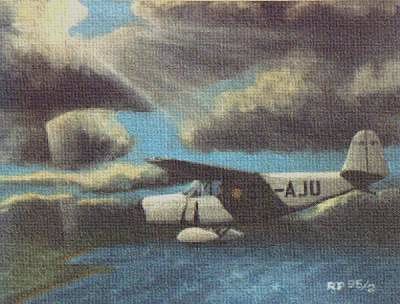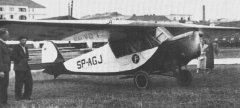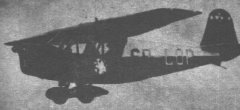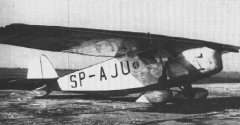 |
|
Stanislaw Jakub
Skarzynski 1 May 1899 - 26 June 1942
Stanislaw Skarzynski was born in Warta on
1st May 1899. His father was the local
Pharmacist. He attended school in Wloclawek
and Kalisz. In 1916/17 he was a member of
the Polish Military Organisation. In
November 1918 he volunteered for the newly
created Polish Army and commanded an action
of disarming German soldiers in Warta.
He fought in the
Polish-Soviet war in the infantry, being
promoted to 2nd Lieutenant in 1919. He was
wounded but returned to the front. During
the battle of Radzymin he was severely
wounded in one leg on 16 August 1920. The
infected wound needed long rehabilitation
and Skarzynski only just avoided being a
complete invalid. He spent two and a half
years in hospital and always limped
thereafter. Unable to serve further in the
army,
he managed to obtain
permission to join military aviation.
Having completed pilot
school in Bydgoszcz (1925), he served in the
1st Aviation Regiment in Warsaw. In 1927 he
was promoted to Captain. Between 1st
February and 5 May 1931 he flew around
Africa together with Navigator Lt. Andrzej
Markiewicz, in a Polish designed (J
Dabrowski) aircraft PZL L-2 (reg no SP-AFA),
a distance of 25,770 km.
On
7/8 May 1933, Skarzynski flew solo in a
small Polish tourist aeroplane RWD- 5bis (reg
no SP-AJU) across the southern Atlantic from
Saint-Louis Senegal to Maceio Brazil. The
flight took 20 hours 30 minutes (17 hours 15
minutes over the ocean). He crossed 3,582 km
establishing a World Record for a FAI
Category 2 tourist plane (weight below 450
kg).
The RWD-5bis was - and still is
- the smallest aeroplane ever to have flown
the Atlantic. Until the last moment plans of
his flight were kept secret. It became part
of a Warsaw to Rio de Janeiro flight (27
April to 10 May) a distance of 17,885 km. He
then flew on to Buenos Aires.
|
He
returned to France by ship, then flew home
to Warsaw. In 1934 he was promoted to Major.
He commanded a bomber squadron and in
1938 became deputy
Commanding Officer of the 4th Aviation
Regiment in Torun with a rank of Lt Colonel.
In April 1939 he became President of the
Aero Club of the Republic of Poland.
In
1939 he was sent to Romania as deputy Air
Attaché. After the outbreak of World War II,
he helped to transfer Polish pilots through
Romania to France where the Polish Air Force
was recreated. In 1940, he himself got to
France and on the fall of France helped with
Gen Zajac and Col Karpinski to transfer
Polish airmen by ship to Great Britain. Here
the Polish Air Force was rebuilt and
Skarzynski became Commanding Officer,
firstly in RAF Hucknall and then of the
Polish Flying School in RAF Newton. He
however asked to serve in a combat unit and
was assigned as Commanding Officer of the
RAF Lindholme Air Base and a pilot in the
305 Polish Bomber Regiment.
After
midnight on 26 June 1942, returning from a
great bombing mission over Bremen his
Wellington was forced to land in the North
Sea due to damage to the engine. Skarzynski
put down the heavily damaged aircraft so
expertly in the stormy sea that all the crew
was saved. Skarzynski leaving the Wellington
last was washed to sea and was the only crew
member lost. His body was washed ashore and
he was buried on the Dutch island of
Terschelling.
He was awarded, among
others, the Silver Cross of the Order of
Virtuti Militari (5th class), the Cross of
Independence, the Officer Cross of the Order
of Polonia Restituta (4th Class), the Cross
of Valour (four times), the gold and Silver
Crosses of Merit, the French Legion
d’Honneur, the Officer Cross of the
Brazillian Order of the Southern Cross, the
Romanian Cross of the Crown of Romania, the
Hungarian Cross of Merit etc. The F.A.I
awarded him the Louis Bleriot Medal in 1936,
of which he was one of the first recipients.
Posthumously he was made a full Colonel
and Aleksander
Kwasniewski, the President of Poland,
awarded him posthumously the Order of
Polonia Restituta 2nd Class.
There are numerous streets and schools named
after him and he is the Patron of the
AeroClub of Wloclawek and of the 13th Air
Transport Squadron in Krakow. On 10 August
2009 the Minister of National Defense signed
the Decree appointing him Patron of the Air
Base in Balice-Krakow. A Statue of Col
Skarzynski stands on the Base and one on the
Main Square in Warta, his birth place. His
bust stands in the Hall of Fame in Mexico
City Airport.
The Polish Air Base in Krakow
Poland
has adopted him as their Patron and all
march-pasts are held there in front of his
statue where flowers are laid.
Many streets, schools and scout
groups now carry his name.
Stanislaw
Jakub Skarzynsk
was the last pre war President of the aero
club of Poland
and that in 1939 as deputy Air Attaché in
Bucharest,
Romania, he helped many of
the Polish Air Force to
France. On
the fall of
France he was
instrumental in transferring 17,000 Polish
airmen to Great Britain where the Polish Air
Force was reformed.
We would like to thank Maciej Skarzynski,
the son of Stanislaw
Jakub Skarzynsk for all his help in
providing Avstop with is information.
|





